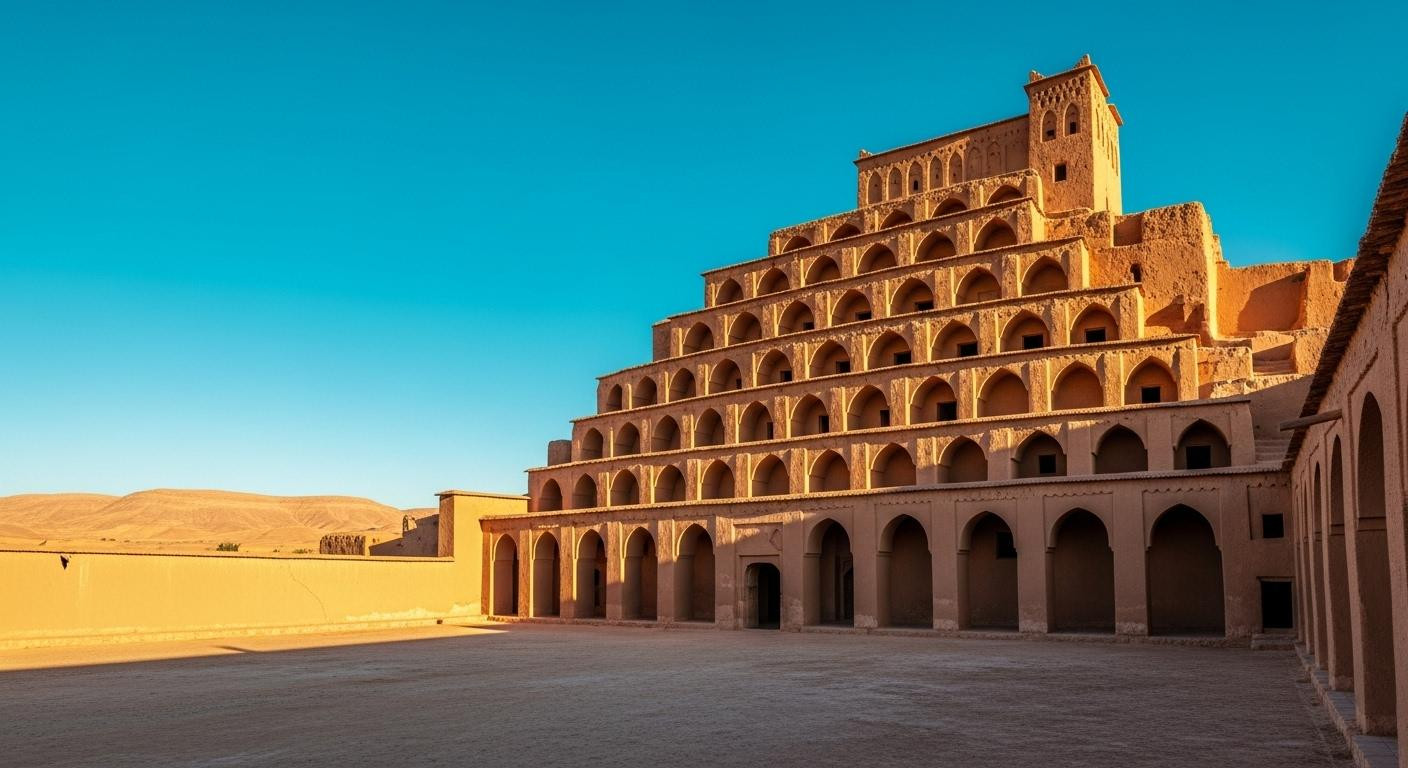Dawn at 6:47 AM in Ksar Ouled Soltane’s west courtyard. Steam rises from mint tea while golden light touches 400 vaulted storage rooms stacked four stories high. No tour buses for three more hours. This isn’t Morocco’s Aït Benhaddou with its daily convoys, nor Jordan’s Petra with million-visitor crowds. This is Tunisia’s 15th-century Berber granary where November’s 68-82°F temperatures reveal what 40,000 annual visitors discover: authentic desert architecture at half Morocco’s cost, with Friday tribal gatherings still echoing through adobe corridors.
Neither Morocco’s tourist routes nor Jordan’s Petra crowds
Morocco welcomed 17.4 million visitors in 2024 while Tunisia received 9.7 million. The numbers tell only part of the story. Aït Benhaddou sees 300,000 annual visitors versus Ksar Ouled Soltane’s 40,000-50,000. Petra charges $70 entry fees while Tunisia’s accessibility costs nothing beyond the 12-mile taxi ride from Tataouine.
November timing delivers the advantage Morocco can’t match. Temperatures hover between 68-82°F versus summer’s brutal 86-104°F extremes. Post-coastal-season tranquility settles over southern Tunisia. Desert silence replaces the merchandising saturation of Star Wars tourism elsewhere.
Geographic isolation at 1,150 feet elevation creates the serenity Morocco’s tourist infrastructure destroys. Wild herb scents drift through 93-mile desert expanses. The ksar sits 12 miles south of Tataouine, accessible by paved roads without organized tour requirements.
Where 400 ghorfas stack four stories into desert sky
Two connected courtyards stretch 197 by 131 feet across rolling desert hills. The west courtyard dates to 1699, the eastern addition from the mid-1800s. Four hundred vaulted storage chambers rise in labyrinthine geometry tourists never expect.
Labyrinthine adobe geometry tourists never expect
Multi-story vaulted storage chambers connect via steep external staircases. Each narrow archway frames desert views through geometric patterns. Palm wood passages link the courtyards while preserving defensive architecture. Traditional calligraphy motifs decorate doors and windows where families stored grain for 500 years.
Where Berber families stored grain for centuries
Each ghorfa belonged to a single family, fortified against raids and climate extremes. Friday afternoon tribal meetings still occur in the main courtyard. The 1993 and 1997 restorations employed cement rather than original mud bricks, sparking authenticity debates among preservation specialists.
National heritage landmark status protects the site without UNESCO’s tourism pressures. Functional granaries evolved into cultural monuments while maintaining community connections.
Walking through Star Wars filming sites at November’s golden hour
Southern Tunisia served as Tatooine’s backdrop without the merchandising saturation. Desert winds create acoustic effects through vaulted chambers. Sunset at 5:45 PM transforms ochre walls into living sculpture.
Climbing steep staircases to four-story views
Physical exploration reveals architectural secrets tour buses miss. Narrow external stairs wind between arched doorways. Textured adobe contrasts with smooth palm wood passages. Fourth-story ghorfas frame 360-degree desert panoramas perfect for photography without crowds blocking compositions.
Couscous with desert herbs locals actually cook
Tataouine’s markets supply ingredients for $6-12 traditional meals. Brik (fried pastry with lamb filling) costs $3-4 locally. Grilled lamb with Berber spices accompanies fresh dates and olive oil from regional presses. Morning mint tea rituals continue unchanged since the granary’s founding.
Friday communal dining customs welcome respectful visitors. Family-owned restaurants serve recipes passed through generations without tourist markup pricing.
At $40 per night when Morocco charges $120
Budget guesthouses in Tataouine cost $25-45 nightly versus Morocco’s kasbah rates. Mid-tier accommodations run $50-90 compared to Marrakech’s $120+ premium. Guided tours cost $15-25 per person without Morocco’s infrastructure overhead.
Car rental from Djerba airport ranges $35-50 daily for the 93-mile drive. Regional pricing averages 20-30% below Tunisia’s national rates. November accommodation drops further as coastal tourism seasons end.
Standing in the west courtyard at dusk, ochre walls shift to deep orange. Desert wind replaces tour guide megaphones. Three hundred ninety-nine other ghorfas stretch untouched around ancient courtyards where authenticity costs half what Morocco demands.
Your questions about Ksar Ouled Soltane answered
When should I visit to avoid heat and crowds?
October-November (68-82°F) and March-April (59-77°F) offer ideal conditions. November provides post-summer tranquility with fewer than 3,500 monthly visitors versus summer’s coastal tourist overflow. Avoid June-August’s 86-104°F extremes when desert heat becomes dangerous.
How do I actually get there from the US?
Fly to Tunis-Carthage (TUN) or Djerba-Zarzis (DJE) airports. Rent cars for the 373-mile drive from Tunis or 93 miles from Djerba. Arrange Tataouine taxis for $11-18 one-way covering the final 12 miles. No trains serve the desert region. Total flight plus rental costs approximately $800-1,200 depending on season.
Is this really less crowded than Morocco’s kasbahs?
Significantly less crowded with 40,000-50,000 annual visitors versus Aït Benhaddou’s 300,000 plus. No organized tour bus infrastructure exists. Most visitors are independent travelers or Star Wars enthusiasts, not mass tourism groups. Friday gatherings remain authentic community events rather than tourist performances.
Morning light at 6:47 AM finds you alone on fourth-story ghorfa ledges. Desert silence except for wind through adobe vaults. Three hundred ninety-nine other storage chambers wait untouched around two courtyards. This isn’t Morocco’s crowds or Jordan’s entry fees. This is Tunisia’s quiet secret, and November keeps it exactly that way.
